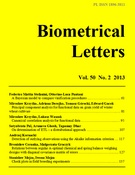
Biometrical Letters Vol. 50(2), 2013, pp. 61-80


The effects of three pre-fermentative techniques (standard procedure, cold soak pre-fermentation and cryomaceration), temperature (20 or 30°C) and saignée (with/without) on the extraction of total anthocyanins were investigated during maceration of must obtained from Sangiovese grapes. A Bayesian hierarchical model was developed to estimate time-dependent contrasts while addressing the peculiar features displayed by the experimental units (wine tanks): substantial heterogeneity among replicates, departure from low-order 'textbook' kinetics and the occasional presence of very low observations. Prior distributions of critical model parameters were elicited with the help of wine-making experts and by considering the results of previous experiments. The posterior distribution of model parameters was approximated by Markov Chain Monte Carlo simulation using JAGS software. Among the main findings, it is to be highlighted that temperature and saignée increased the total anthocyanin concentration in all the techniques, although at different times during maceration. In all the procedures the total anthocyanin gain decreased as the maceration came to an end.

semiparametric regression, outliers, MCMC, wine making, pre-fermentation treatments

